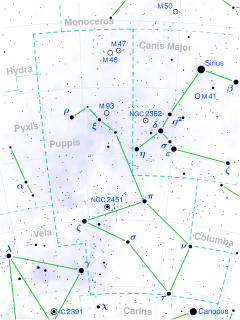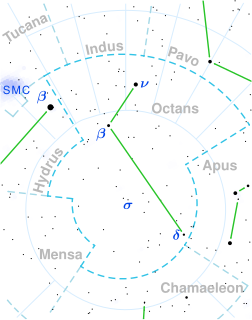
ν Persei, Latinized as Nu Persei, is a single star and a suspected variable in the northern constellation of Perseus. It has a yellow-white hue and is visible to the naked eye with an apparent visual magnitude of 3.80. This object is located approximately 560 light-years from the Sun based on parallax but is drifting closer with a radial velocity of −12 km/s.

γ Monocerotis, Latinised as Gamma Monocerotis, is a binary star system in the equatorial constellation of Monoceros. Based upon an annual parallax shift of 6.55 mas, it is located roughly 500 light years from the Sun. It can be viewed with the naked eye, having an apparent visual magnitude of 3.96. Gamma Monocerotis is moving away from the Sun with a radial velocity of −5 km/s.
Zeta Monocerotis, Latinized from ζ Monocerotis, is a single, yellow-hued star in the constellation Monoceros. It has an apparent visual magnitude of 4.33, which is bright enough to be visible to the naked eye. The annual parallax shift as measured during the Hipparcos mission is 3.08 milliarcseconds, which provides a rough distance estimate of 1,060 light years. It is moving away from the Sun with a radial velocity of +30 km/s.

66 Ophiuchi is a solitary variable star in the equatorial constellation of Ophiuchus. It has the variable star designation V2048 Ophiuchi, while 66 Ophiuchi is the Flamsteed designation. This object is visible to the naked eye as a faint, blue-white hued point of light with a baseline apparent visual magnitude of 4.60. It is located approximately 650 light years away from the Sun based on parallax, but is drifting closer with a radial velocity of −13 km/s. The star has a peculiar velocity of 13.1±3.2 km/s relative to its neighbors.

31 Pegasi is a single star in the northern constellation of Pegasus. It is visible to the naked eye as a dim, blue-white hued point of light with a baseline apparent visual magnitude of 4.99. It is located approximately 1,600 light years away from the Sun based on parallax, but is drifting closer with a radial velocity of −5.3 km/s.

72 Pegasi is a binary star system in the northern constellation of Pegasus. It is visible to the naked eye as a faint, orange-hued point of light with a combined apparent visual magnitude of 4.97. The system is located approximately 550 light years away from the Sun, based on parallax, but is drifting closer with a radial velocity of −25 km/s.

17 Persei is a single star in the northern constellation of Perseus, located about 390 light years away from the Sun. It is visible to the naked eye as a faint, orange-hued star with an apparent visual magnitude of 4.53. This object is moving further from the Earth at a heliocentric radial velocity of +13 km/s.

Delta Pictoris is a class B3III star in the constellation Pictor. Its apparent magnitude is 4.72 and it is approximately 1300 light years away based on parallax.

HD 70060 is a class A8V star in the constellation Puppis. Its apparent magnitude is 4.45 and it is approximately 93.4 light years away based on parallax.

QZ Puppis is a class B2.5V star in the constellation Puppis. Its apparent magnitude is 4.49 and it is approximately 650 light years away based on parallax.

HD 65810 is a class A2V star in the constellation Puppis. Its apparent magnitude is 4.61 and it is approximately 241 light years away based on parallax.

HD 64740 is a class B1.5V star in the constellation Puppis. Its apparent magnitude is 4.63 and it is approximately 760 light years away based on parallax.

NV Puppis, also known as υ1 Puppis, is a class B2V star in the constellation Puppis. Its apparent magnitude is 4.67 and it is approximately 800 light years away based on parallax.

HD 59890 is a class G3Ib star in the constellation Puppis. Its apparent magnitude is 4.65 and it is approximately 1500 light years away based on parallax.

HD 63744 is a class K0III star in the constellation Puppis. Its apparent magnitude is 4.71 and it is approximately 232 light years away based on parallax.

HD 68601 is a class A7Ib star in the constellation Puppis. Its apparent magnitude is 4.75 and it is approximately 4,200 light years away based on parallax.

MX Puppis is a class B1.5IV star in the constellation Puppis. Its apparent magnitude varies irregularly between magnitude 4.6 and 4.9 and it is classified as a Gamma Cassiopeiae variable. It is approximately 930 light years away based on parallax.

HD 54893 is a class B2IV star in the constellation Puppis. Its apparent magnitude is 4.83 and it is approximately 730 light years away based on parallax.

HD 172910 is a class B2.5V star in the constellation Sagittarius. Its apparent magnitude is 4.87 and it is approximately 467 light years away based on parallax.

Epsilon Octantis, Latinized from ε Octantis, is a star in the southern circumpolar constellation of Octans. It is a faintly visible to the naked eye with an apparent visual magnitude of 5.09. The annual parallax shift of 11.22 mas yields a distance estimate of around 291 light years. It is moving further from the Sun with a radial velocity of +11.7 km/s.








